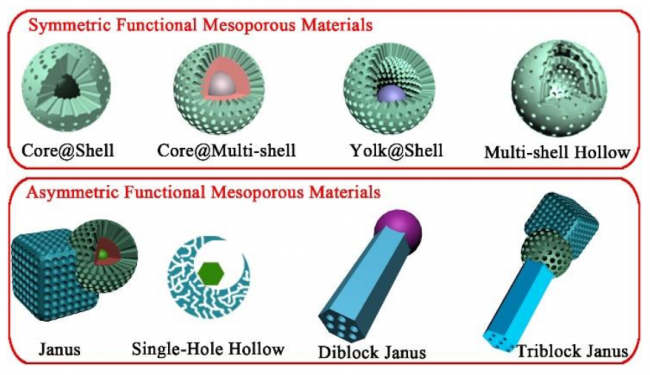报告题目:Multi-Functional Mesoporous Nanoparticles: from Symmetry to Asymmetry
报 告 人:Dongyuan Zhao (Department of Chemistry, Laboratory of Advanced Materials and Collaborative Innovation Center of Chemistry for Energy Materials, Fudan University)
报告时间:2017年10月18日(星期三)下午16:00~17:00
报告地点:化学馆241室
欢迎相关专业师生前来参加交流!
Abstract:
Besides conventional symmetric hybrid materials such as core-shell, yolk-shell etc.,anisotropic composite particles with asymmetric nanostructures have aroused extensive concern for their unique characteristics and potential applications. Enlightening by the anisotropic growth of the inorganic crystals, we developed the surfactants micelles oriented anisotropic growth strategy for the fabrication of the asymmetric ordered mesoporous nanocomposites. By using this novel anisotropic growth strategy, series of asymmetric functional mesoporous nanocomposites with asymmetric nanostructures on geometry, chemical composition, surface property, and functionality etc. were developed, including Janus, Single-Hole Hollow, Nano-thermometer, Triblock Janus etc. Most importantly, the obtained asymmetric nanocomposites possess unique multiple independent surfaces, compositions, functions etc., which are ideally for the co-delivery of multi-guests with quite different properties (hydrophilicity/hydrophobicity, acidity/basicity, sizes etc.). The obtained asymmetric functional mesoporous materials with uniform and controllable pore channels, high surface area and open frameworks, showing great potential applications on catalysis, adsorption, and biomedicine.

Figure 1. The scheme illustration of the obtained symmetric and asymmetric functional mesoporous materials.
References:
Y. H. Deng, et al, J. Am. Chem. Soc., 130, 28 (2008); Y. Fang, et al, Angew. Chem. Int. Ed., 49, 7987 (2010).W. Li, et al, J. Am. Chem. Soc., 134, 11864 (2012); W. Li, et al, Adv. Mater., 25, 5129 (2013); Y. Fang, et al, Angew. Chem. Int. Ed., 53, 5366 (2014). X. M. Li, et al, J. Am. Chem. Soc., 136, 15086 (2014); D. K. Shen,et al, Nano Lett., 14, 923 (2014); Y. Fang, et al, J. Am. Chem. Soc., 137, 2803 (2015); W. Li, et al, Nano Lett., 15, 2186 (2015); B. Kong, et al, Nature Chem., 8, 171 (2016).
报告人简介:

赵东元教授,1963 年出生于沈阳市。 1980 年考入吉林大学化学系,1984 年获得理学学士学位,1987 年获吉林大学化学系理学硕士学位。 1990 年获吉林大学和大连化学物理研究所物理化学专业理学博士学位。 1993 ~ 1994 年在以色列魏兹曼科学院化学物理系做博士后。 1995 ~ 1996年在美国休斯顿大学化学系做博士后。 1996 ~ 1998 年在美国加州大学圣芭芭拉分校材料系和化学系做博士后。 1998 年 12 月复旦大学教授;2000 年入选教育部长江“特聘教授”,2007 年被增选为中科院院士。 2010 年被增选为第三世界科学院(TWAS)院士。
主要从事沸石分子筛、纳米介孔材料合成、结构和在催化、电池、生物、水处理等能源方向应用的研究工作。在国际重要刊物上发表 SCI 论文 600 余篇,包括:Nature (2); Science (2); Nature Materials (1); Nature Chemistry (1);Nature Comm (4); Science Adv (1); J Am Chem Soc (53); Angew. Chem. (31);Adv. Mater. (32);获中国专利授权 39 项。论文被引用近 8 万次(h index =133)。曾获得 2004 年度国家自然科学二等奖; 2008 年 TWAS 化学奖;2008年国际介观结构材料协会奖;2009 年何梁何利科学进步奖;2011 年美国加州伯克利大学 Earl Muetterties Memorial Award,2013 年印度化学会 RaoAward。 被列为 100 名全球引用率最高的化学家之一,被汤森路透社列为全球化学、材料两个领域高被引科学家;也被列为最具国际影响力的中国科学家;现任国际介观结构材料协会 IMMA 主席、 国际刊物 ACS Central Science 编辑。曾任英国皇家化学会 Journal of Materials Chemistry 主编、 Journal of Colloid Interface Science 编辑(Co-Editor),任十几种国际重要刊物如:Journal of The American Chemical Society、 Chemistry-An Asian Journal、 Chemistry of Materials、 Dalton Transactions,Nano,NanoToday、 Nano Research、Advanced Energy Materials 等国际刊物的编委、顾问编委。